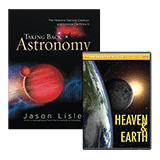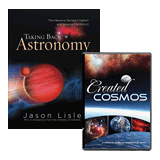Moon Inching Away from an Old Earth
How measurable lunar recession argues against a multi-billion year old universe and indicates a recently-created moon in line with the biblical account
Every year, the moon moves an inch or so farther away from earth. It may not seem like much, but that tiny movement puts a big limit on the moon’s age.
How Old Is Our Moon?
The Bible says God made the moon on Day Four of Creation Week, and the Bible’s genealogies reveal that this happened roughly 6,000 years ago. But that’s not the story we hear today. Most science museums, websites, TV shows, and textbooks claim the moon formed by natural processes about 4.5 billion years ago. How do we resolve such vast differences?
God’s Word is true in everything it claims (Psalm 119:160). Jesus Christ, the Son of God and Creator of the universe, affirmed this (John 17:17). And if His Word is true, we would expect to find abundant scientific evidence to support His claims.
We can calculate the maximum possible amount of time the moon has been orbiting the earth—and it’s not 4.5 billion years.
Our moon has many age indicators that support the Bible’s teaching that creation happened thousands, not billions, of years ago. One of the more interesting is an effect of gravity called lunar recession. Ever so slowly, the moon is slipping away from the earth. By measuring this rate, we can calculate the maximum possible amount of time the moon has been orbiting the earth—and it’s not 4.5 billion years.
For decades, creationists have cited this phenomenon as powerful evidence in favor of the Bible’s history. Secular scientists, in contrast, have tried to find a way to save their idea that the moon is extremely old. How well do their rescuing devices stand up?
Lunar Recession

First, let’s discuss why the moon is moving away from earth. The moon’s gravity causes the earth’s ocean water to bulge toward the moon. As the earth rotates, parts of its surface move in and out of the region of oceanic bulging. (This makes local sea levels rise and fall in tides.) However, as the earth rotates under the bulge, friction drags the bulge forward. This bulge exerts its own gravitational effect on the moon and accelerates it in its orbit, causing it to move away from earth over time.
Although it’s been known for a long time that the moon should be receding from our planet, the Apollo lunar program of the 1960s and 1970s allowed scientists to measure this process with great precision. Over the last 40 years or so, the moon’s average distance has increased by roughly 1.5 inches (3.8 cm) per year.
This might seem like obscure scientific data, but it’s very important. This measurement allows us to calculate a maximum age for the earth-moon system.
A Lunar Clock
If the moon is steadily receding from the earth, then in the past, it was closer. Based on today’s rate of recession, the moon would have been touching the earth about 1.5 billion years ago.
Of course, this doesn’t mean that the moon was ever that close. It’s just the logical limit to the physical process we observe today. We can use this limit as a sort of clock. According to this clock, the earth-moon system cannot be more than 1.5 billion years old.
Here’s an important point about this calculation. It does not reveal the precise age of the earth-moon system. It merely tells us the maximum age.
The biblical age of the moon (about 6,000 years) fits this clock just fine. In fact, the moon has not moved outward very far—less than 1,000 feet (300 m)—since it was created.
But what doesn’t fit this clock is a moon that’s over four billion years old.
Attempted Secular Rebuttals
Secular scientists have known for over 50 years that a straightforward analysis of the moon’s recession is a “major problem” for their billions-of-years interpretation of earth history.
Lunar recession is not merely a side issue. This confirmed process poses a major threat to evolutionary theories overall, which require billions of years. So it’s not surprising that evolutionists have attacked its reliability as a clock.
One common challenge, that the calculation is wrong, still appears sometimes on the Internet. But no serious astronomer claims this. It goes something like this: “A recession rate of 1.5 inches per year, over 4.5 billion years, produces a total recession of less than half the moon’s current distance. So there’s no problem here after all.”
However, this assertion is both naïve and false. It assumes that the recession rate is linear and does not change over time. In reality, mathematics dictates that the recession rate would have been much higher in the past, when the moon was closer to the earth.
About the only way to get a slower rate is to invoke different physical conditions in the past. This is the preferred explanation among secular scientists. They claim that today’s recession rate is abnormally high.
To support this claim, they offer multiple forms of evidence.
Geological Evidence
Sometimes rock layers are found in repeating patterns called rhythmites. Secular geologists have identified certain rhythmite formations as ancient tidal deposits. These deposits are then used to “confirm” that the moon’s rate of recession was much lower in the past.
But this claim is hollow. Rhythmites don’t necessarily tell us anything about past tidal cycles, because non-tidal flooding can create similar deposits. (A glacial flood in Iceland deposited about 50 feet [15 m] of rhythmites in just two days back in 1996.) Also, genuine tidal sediments have distinctive patterns that these rhythmites tend to lack. Rhythmites are better explained as deposits laid down quickly by a global Flood.
Paleontological evidence
Secular scientists claim some types of fossils (stromatolites, bivalves, corals, and the like) have measurable growth patterns. From these they calculate ancient day lengths, tidal patterns, and so on. But the same problems apply to these as to rhythmites. The growth pattern counts are often subjective and can’t account for unique conditions that may have existed in the past (such as in the pre-Flood world, which they are unwilling to consider). So these secular calculations are built on unverifiable assumptions. They do not provide independent proof that the lunar recession rate was ever different.
Scientific modeling
Geophysicists have done extensive modeling of the earth-moon system. Some anti-creationist websites claim these models support much slower recession rates in the past.
But that’s possible only by making a set of assumptions. For example, to reduce tidal friction (and thus reduce the recession rate), these models require the earth’s landmass to be distributed much differently than it is today. Some models have all the continents combined into one supercontinent at the equator or one of the poles.
Note that this is not how the earth is today. Nor does it really match what most secular geologists believe anyway, that is, that there was a series of supercontinents, which repeatedly broke up and reformed over more than three billion years. (Many creationists believe something similar happened, but within the one year of the global Flood.) And somehow, this all had to take place without significantly affecting the moon’s recession rate until very recently.
Also, oceanography research has invalidated one of the key assumptions of the secular models: that tidal friction occurs only in shallow seas and continental shelves. It turns out that friction and dissipation of tidal energy occur in the deep oceans, too. So these supercontinent models have not solved the recession problem after all.
An Admission That The Past Was Not As Today
This last point is very important. Evolution is based on a uniformitarian approach, that is, that “the present is the key to the past.” Secular scientists are adamant that we can base scientific explanations only on present-day observations. Accordingly, they presuppose that the Bible is invalid as an interpretive framework because it describes events (such as a worldwide Flood) that are not occurring today.
Yet in an attempt to solve their lunar recession problem, secular thinkers claim that the earth was much different in the past than it is observed to be today. If they can’t observe the unique events that shaped our earth and moon in the past, why won’t they consider God’s record in the Bible? Science is not the problem!
Lunar recession is not precise enough to give us the actual age of the earth-moon system (which is only thousands of years). But the moon’s recession does debunk many of the foundational assumptions and billions- of-years requirements of long-age models.
The psalmist wrote, “The heavens
declare the glory of God
” (Psalm 19:1).
As science progresses, we continue to
discover more ways in which the heavenly
bodies declare the glory of their
Creator.
Related Videos
Our Created Solar System Excerpt
Answers Magazine
March–April 2017
How do we see our Creator in the kitchen? The infinite diversity of delicious food shows His lavish love.
Browse Issue SubscribeRecommended Resources

Answers in Genesis is an apologetics ministry, dedicated to helping Christians defend their faith and proclaim the good news of Jesus Christ.
- Customer Service 800.778.3390
- © 2024 Answers in Genesis







